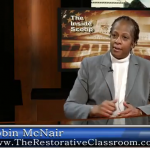Restorative Practices in Schools – Robin McNair
(Dec. 18, 2017) Catherine Read speaks with Robin McNair, Educator and Restorative Practices Practitioner. Robin teaches 9th grade history at Dr. Henry A. Wise Jr. High School in Upper Marlboro, Maryland. She has been trained in the use of restorative practices in schools, which is a framework for building community and responding to challenging behavior through authentic dialogue, coming to understanding, and making things right.
The use of restorative practices in schools was born from the idea of restorative thinking, which is a shift away from punishment-oriented approach to discipline. People, including students, who are invited into restorative dialogue are sometimes confused by the concept of “making things right”. Their default response to the question “What can we do to make things right?” often has to do with punishment. It is said that children live what they learn. When what they have learned is that troublesome behavior demands a punishment-oriented response, then that is how they will live. Restorative practices invite different ways of responding.
Restorative Justice, as used in the criminal justice environment, brings persons harmed by crime and the person who harmed them, along with affected family and community members, together in dialogue that aims to build understanding, explore how the crime has impacted those involved, and collectively develop agreements for what will be done to make things right. These dialogues take place with participants sitting in a circle, so they are sometimes called circle dialogues.
In a school setting, restorative practices cultivate a culture in which everyone feels like they belong. They build a particular sense of community in which every member – students, teacher, parent volunteers, aids feel like they are seen, heard and respected.
McNair shares that school discipline has for the most part taken its cue from the criminal justice system. The focus is on the punishing wrongdoers with the aim of enforcing behaviors that are safe and non-disruptive. When punishment does not work, misbehaving students may be excluded through suspension or expulsion, with the possibly serious long-term harmful consequences to them and to society. There is little or no opportunity for social an emotional learning. McNair notes that minority students are disproportionately affected by these harmful practices.
As outlined in Nancy Reistenberg’s book Circle in the Square, the use of circle dialogue in the classroom gives each student the opportunity to be heard. High quality prompts are questions that give the circle its energy and focus. The circle keeper invites everyone in the circle to participate and respond to the prompts. This both builds trust and encourages the class to work together to identify and solve problems that interfere with learning. While the teacher is still in charge, there is a shift to shared responsibility for behavior management. Solving problems and coming up with solutions becomes more of a team effort. This approach encourages a dialogue where understanding is reached and there is opportunity for creating mutually acceptable agreements about how to make things right.
There is a growing body of research supporting the effectiveness of restorative practices in schools. Evidence shows that restorative practices can result in reductions of suspensions and expulsions, less instructional time lost to managing student behavior challenges, and fewer disciplinary referrals to principals, especially for minority students. The use of restorative practices can also increase teacher morale and teacher retention, along with improved academic outcomes. Ms. McNair shared that the book Restorative Justice in Education (a Little Book Series) is a wonderful resource for educators who are interseted in getting started with learning about restorative practices.
